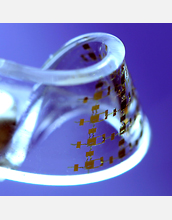Multimedia Gallery
Stretchable and Twistable Electronics
New bendable, foldable, twistable electronic device.
More about this Image
Yonggang Huang, a Joseph Cummings professor of civil and environmental engineering and mechanical engineering at Northwestern University's McCormick School of Engineering and Applied Science, and John Rogers, the Flory-Founder chair professor of materials science and engineering at the University of Illinois at Urbana-Champaign, have developed circuits that can stretch, bend and even twist!
In the past there have been limits for the use of electronic components--which have been flat and unbendable--due to the fact they are made primarily of silicon, which is brittle and inflexible. Bending or stretching would make the component useless.
Now, Huang and Rogers have developed a process to produce stretchable electronics, increasing the stretching range by as much as 140 percent and allowing users to subject circuits to extreme twisting. The new technology improved upon several past developments by the pair.
In 2005, they developed a one-dimensional, stretchable form of single-crystal silicon that could be stretched in one direction without altering its electrical properties. This was followed by another new technology which allowed circuits to be placed on a curved surface. An array of circuit elements, approximately 100 micrometers square, were connected by metal "pop-up bridges," then placed on a curved surface. The system was successful because the metal wires connecting the elements popped up when bent or stretched. With Huang and Roger's new development, they took the pop-up bridges and made them into an "S" shape and, in addition to bending and stretching, they have enough give that they can be twisted as well.
"For a lot of applications related to the human body--like placing a sensor on the body--an electronic device needs not only to bend and stretch but also to twist," said Huang. "So we improved our pop-up technology to accommodate this. Now it can accommodate any deformation."
This emerging technology will be ideally suited in instances where flat, unbendable electronics would fail. Potential uses include flexible sensors, transmitters and new photovoltaic and microfluidic devices, as well as areas of medicine and athletics. Huang and Rogers are also looking into possible application of their technology in solar panels. [This research was supported by the National Science Foundation (grant ECCS 08-24129) and the Department of Energy.] (Date of Image: October 2008)
Credit: John Rogers, University of Illinois
Images and other media in the National Science Foundation Multimedia Gallery are available for use in print and electronic material by NSF employees, members of the media, university staff, teachers and the general public. All media in the gallery are intended for personal, educational and nonprofit/non-commercial use only.
Images credited to the National Science Foundation, a federal agency, are in the public domain. The images were created by employees of the United States Government as part of their official duties or prepared by contractors as "works for hire" for NSF. You may freely use NSF-credited images and, at your discretion, credit NSF with a "Courtesy: National Science Foundation" notation.
Additional information about general usage can be found in Conditions.
Also Available:
Download the high-resolution JPG version of the image. (1 MB)
Use your mouse to right-click (Mac users may need to Ctrl-click) the link above and choose the option that will save the file or target to your computer.

